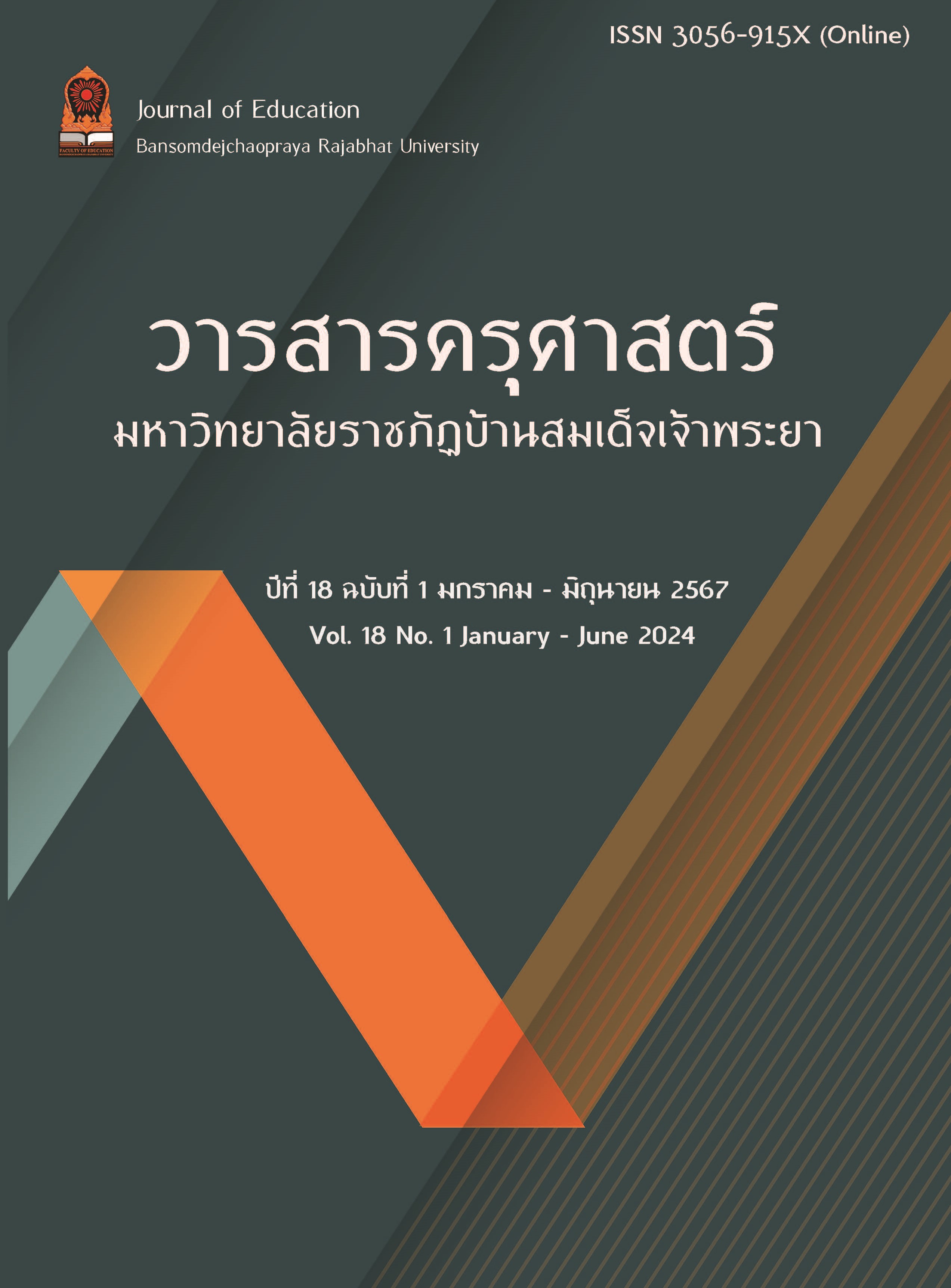Developing self-directed learning abilities through a problem-based learning approach for fourth-year students.
Keywords:
Self-directed learning ability, learning management, problem-based learningAbstract
This research aims to compare the self-directed learning abilities using problem-based learning approach among fourth-year students before and after the course. The sample group consisted of 21 fourth-year students in the field of Public Administration from the Faculty of Humanities and Social Sciences, Bansomdejchaopraya RajabhatUniversity, enrolled in the course coded 213412 "Leadership Traits" during the first semester of the academic year 2566. The sample group was selected through cluster random sampling. Research instruments were 1) a problem-based learning management plan. All learning plans have a Index of Item Objective Congruence of 1.00. A self-directed learning ability assessment have a Index of Item Objective Congruence of 1.00 and a reliability coefficient of 0.84.The statistics used in the research comprised mean, standard deviation, and compare t-test for dependent samples.
The result of research were as follows:
1) The problem-based learning approach was in the leadership subject, 3 learning units. Each learning unit is 4 hours, totaling 12 hours: 1) Governance of Leaders 2) Modern Leadership 3) Case Studies of Thai and Global Leaders. Included five teaching steps: 1) Problem Design 2) Scenario Creation 3) Group Work 4) Presentation and Discussion and 5) Evaluation and Summary.
2) Self-directed learning abilities through problem-based learning among fourth-year students showed a statistically significant improvement in post-learning average scores compared to pre-learning scores at the .01 level. It can be considered that there was an increase in self-directed learning ability.
Downloads
References
เรวดี จันทร์รัศมีโชติ, พงศ์เทพ จิระโร, สมโภชน์ อเนกสุข.การพัฒนารูปแบบการเรียนรู้ด้วยตนเองของนักศึกษาชั้นมัธยมศึกษาปีที่ 3 โดยการประยุกต์ทฤษฎีคอนสตรัคติวิซึมสู่การเรียนรู้ด้วยกระบวนการวิจัย. คณะศึกษาศาสตร์, มหาวิทยาลัยบูรพา.
ทิศนา แขมมณี (2556). ศาสตร์การสอน องค์ความรู้เพื่อการจัดกระบวนการเรียนรู้ที่มีประสิทธิภาพ (พิมพ์ครั้งที่17). กรุงเทพฯ : สำนักพิมพ์แห่งจุฬาลงกรณ์
พระพันธวัฒน์ ธมฺมวฑฺฒโน (ภูมิรัง) และวิทยา ทองดี. (2565). “การจัดการเรียนรู้แบบใช้ปัญหาเป็นฐาน (Problem–based Learning) MANAGEMENT OF PROBLEM-BASED LEARNING”. มจร อุบลปริทรรศน์, 7(1), 967-976.
สุคน สินธพานนท์. (2560). ผู้สอนยุคใหม่กับการจัดการเรียนรู้สู่การศึกษา 4.0. ห้างหุ้นส่วน จำกัด 9119 เทคนิคพริ้นติ้ง: กรุงเทพ
Anderson, M. (2016). Learning to Choose Choosing to Learn: The Key to Student Motivate & Achievement. Alexandria, VA: AS
Council on Social Work Education [CSWE]. (2014). Draft 3 of the 2015 Educational Policy and Accreditation Standards (EPAS). Alexandria, VA: Author.
Cronbach, Lee J. (1990). Essentials of psychological testing (5th ed.). New York: Harper Collins.
Fitz - Gibbon & Carol, T. 1987. How to Design a Program Evaluation. Newbury Park: Sage.
Guglielmino, L.M. (1977). Development of the Self-directed Learning Readiness Scale. Doctoral Dissertation. University of Georgia. University of Georgia. Dissertation Abstracts International.
Merrian, S.B. and Caffarella, R.S. (1991). Learning in adulthood. San Francisco: Jossey-Bass Publishers.
Downloads
Published
How to Cite
Issue
Section
License
Copyright (c) 2024 Faculty of Educaion Bansomdejchaopraya Rajabhat University

This work is licensed under a Creative Commons Attribution-NonCommercial-NoDerivatives 4.0 International License.
บทความที่ได้รับการตีพิมพ์เป็นลิขสิทธิ์ของคณะครุศาสตร์ มหาวิทยาลัยราชภัฏบ้านสมเด็จเจ้าพระยา
ข้อความที่ปรากฏในบทความแต่ละเรื่องในวารสารวิชาการเล่มนี้เป็นความคิดเห็นส่วนตัวของผู้เขียนแต่ละท่านไม่เกี่ยวข้องกับมหาวิทยาลัยราชภัฏบ้านสมเด็จเจ้าพระยา และคณาจารย์ท่านอื่นๆในมหาวิทยาลัยฯ แต่อย่างใด ความรับผิดชอบองค์ประกอบทั้งหมดของบทความแต่ละเรื่องเป็นของผู้เขียนแต่ละท่าน หากมีความผิดพลาดใดๆ ผู้เขียนแต่ละท่านจะรับผิดชอบบทความของตนเอง



